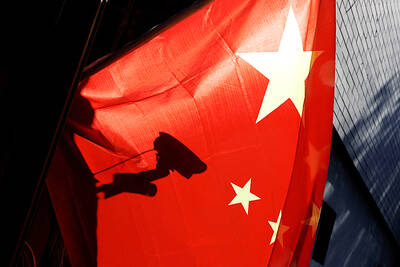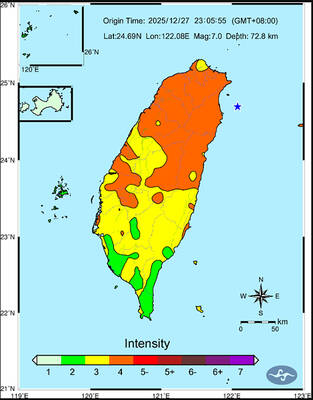A total of 41 US military personnel were stationed in Taiwan as of December last year, a US congressional report said on Friday last week ahead of Tuesday’s passage of an aid package that included US$8 billion for Taiwan.
The Congressional Research Service in a report titled Taiwan Defense Issues for Congress said that according to the US Department of Defense’s Defense Manpower Data Center, 41 US military personnel were assigned for duty in Taiwan.
Although the normalization of relations with the People’s Republic of China (PRC) in 1979 included a vow to withdraw a military presence from Taiwan, “observers have indicated that it is an ‘open secret’ that small numbers of US military personnel conduct work in an advisory capacity” in Taiwan, it said.

Photo: CNA
US defense officials have said they “do not have a comment on specific operations, engagements or training” related to engagements with Taiwan, the report said.
The Wall Street Journal in February last year reported that the US was to send 100 to 200 military training personnel to Taiwan “in the coming months,” which was not confirmed by officials on either side.
In February, US military news Web site SOFREP reported that US Green Berets were permanently stationed in Kinmen County to train Taiwanese forces, which US Indo-Pacific Commander Admiral John Aquilino denied.
SOFREP also highlighted challenges within Taiwan in relation to its defense, saying that there is an apparent lack of trust between elected leaders and the military, which has traditionally been aligned with the opposition Chinese Nationalist Party (KMT).
It also said that there was vulnerability in the nation’s energy, food, water and Internet supply, and it struggles to recruit, train and retain personnel.
“At a societal level, it is not clear what costs — in terms of economic security, physical safety and security, and lives — Taiwan’s people would be willing or able to bear in the face of possible PRC armed aggression,” SOFREP said.
The US and Taiwan “appear to be quietly expanding training activities,” while outlining recent and pending arms transfers to Taiwan, it added.
In other news, progress on stationing a US munitions stockpile in Taiwan is unclear, but there is an “approximate plan” in place, Minister of National Defense Chiu Kuo-cheng (邱國正) said yesterday in response to questions about whether Washington is moving forward with plans to move its East Asia stockpile to Taiwan.
Chiu was responding to a question from Democratic Progressive Party Legislator Wang Ting-yu (王定宇) about progress regarding the alleged stockpile.
On March 6 last year, Chiu told lawmakers that Taipei was “in talks” with the US military on moving its East Asia stockpile to Taiwan.
Chiu yesterday told a meeting of the legislature’s Foreign and National Defense Committee that the issue must be approached with caution, as it involves sensitive political considerations.
There are many ways to define a “stockpile,” he said, adding that the nature of armaments and weaponry is vastly different.
If it were a maintenance center, there would naturally be spare parts and equipment sent in, he said, adding that everything is still in the proposal stage and is open to discussion.

A magnitude 7.0 earthquake struck off Yilan at 11:05pm yesterday, the Central Weather Administration (CWA) said. The epicenter was located at sea, about 32.3km east of Yilan County Hall, at a depth of 72.8km, CWA data showed There were no immediate reports of damage. The intensity of the quake, which gauges the actual effect of a seismic event, measured 4 in Yilan County area on Taiwan’s seven-tier intensity scale, the data showed. It measured 4 in other parts of eastern, northern and central Taiwan as well as Tainan, and 3 in Kaohsiung and Pingtung County, and 2 in Lienchiang and Penghu counties and 1

FOREIGN INTERFERENCE: Beijing would likely intensify public opinion warfare in next year’s local elections to prevent Lai from getting re-elected, the ‘Yomiuri Shimbun’ said Internal documents from a Chinese artificial intelligence (AI) company indicated that China has been using the technology to intervene in foreign elections, including propaganda targeting Taiwan’s local elections next year and presidential elections in 2028, a Japanese newspaper reported yesterday. The Institute of National Security of Vanderbilt University obtained nearly 400 pages of documents from GoLaxy, a company with ties to the Chinese government, and found evidence that it had apparently deployed sophisticated, AI-driven propaganda campaigns in Hong Kong and Taiwan to shape public opinion, the Yomiuri Shimbun reported. GoLaxy provides insights, situation analysis and public opinion-shaping technology by conducting network surveillance

‘POLITICAL GAME’: DPP lawmakers said the motion would not meet the legislative threshold needed, and accused the KMT and the TPP of trivializing the Constitution The Legislative Yuan yesterday approved a motion to initiate impeachment proceedings against President William Lai (賴清德), saying he had undermined Taiwan’s constitutional order and democracy. The motion was approved 61-50 by lawmakers from the main opposition Chinese Nationalist Party (KMT) and the smaller Taiwan People’s Party (TPP), who together hold a legislative majority. Under the motion, a roll call vote for impeachment would be held on May 19 next year, after various hearings are held and Lai is given the chance to defend himself. The move came after Lai on Monday last week did not promulgate an amendment passed by the legislature that

AFTERMATH: The Taipei City Government said it received 39 minor incident reports including gas leaks, water leaks and outages, and a damaged traffic signal A magnitude 7.0 earthquake struck off Taiwan’s northeastern coast late on Saturday, producing only two major aftershocks as of yesterday noon, the Central Weather Administration (CWA) said. The limited aftershocks contrast with last year’s major earthquake in Hualien County, as Saturday’s earthquake occurred at a greater depth in a subduction zone. Saturday’s earthquake struck at 11:05pm, with its hypocenter about 32.3km east of Yilan County Hall, at a depth of 72.8km. Shaking was felt in 17 administrative regions north of Tainan and in eastern Taiwan, reaching intensity level 4 on Taiwan’s seven-tier seismic scale, the CWA said. In Hualien, the